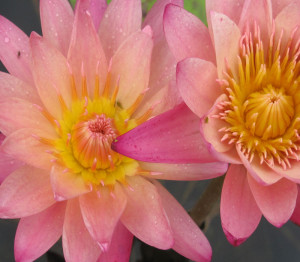 Its officially fall now and we need to begin preparing our pond for the winter and hopefully a cleaner pond for spring. I've listed a few maintenance tips to guide you through preparing your pond for the winter. I still have a few flowers appearing in my pond but I think they are almost through blooming for the season 🙁
Its officially fall now and we need to begin preparing our pond for the winter and hopefully a cleaner pond for spring. I've listed a few maintenance tips to guide you through preparing your pond for the winter. I still have a few flowers appearing in my pond but I think they are almost through blooming for the season 🙁
FALL/WINTER POND MAINTENANCE TIPS
1. Before winter arrives, you will want to make sure your pond and filtering system are clean to ensure good water quality throughout the winter months. With the arrival of fall it is wise to do a partial water change to remove any built up contaminants to improve water quality. Partial water changes need to be made before water temperatures fall below 60 degrees to minimize fish stress. Adding pond salt at this time will improve the slime coating of fish, to help them ward off disease and parasites.
2. Before the leaves begin to fall, cover your pond with one of ourpond nets. The goal is to try and keep the pond as clean as possible for the winter months. Leaves will sink to the bottom of the pond and rot, causing excess carbon dioxide and hydrogen sulfide. After the first frost, take out any floating plants, as these will begin to decay. Trim back hardy lilies and bog plants and place below the freeze line.
3. Switch to Microbe-Lift Autumn/Winter Prep. This will help break down organic material in the pond before winter sets in. Microbe-Lift Autumn/Winter Prep helps accelerate the decomposition of leaves, scum, sediment and other organic matter during the fall and throughout the winter months. Also, Microbe-Lift Autumn/Winter Prep helps to maintain a healthy immune system for your fish during the winter months. Microbe-Lift Autumn/Winter Prep will help jump-start your pond to a healthier environment in the spring.
4.Reduce your fish feeding as the water temperatures drop below 60 degrees. Start feeding your fish a couple of times a week. We recommend switching to a wheat germ based fish food formulated for fall and spring feeding. When water temperatures drop below 60 degrees, the metabolism of your fish slow down. Both Tetra-Pond Spring/Fall and Microbe-Lift Cold Weather fish food are highly digestible cool weather diets that are made with less protein, but contain wheat germ, which is easily digested. They also contain higher levels of fat, which help your fish survive their winter hibernation. When water temperatures reach 50 degrees, stop feeding your fish completely. Feeding at water temperatures below 50 degrees can possibly kill your fish. A pond thermometeris a must have. This will help you in determining when to stop feeding your fish and will also help to know when to begin feeding your fish in the spring. Its also a good idea to know your water temperature for those adding tropical pond plants to your pond in the spring.
5.Adding Microbe-Lift Barley Straw Extract will help control string algae throughout the fall and winter months. Barley Straw Extract is an effective and eco-friendly way to reduce algae. Unlike algaecides, which are ineffective in water temperatures below 50 degrees, Microbe-Lift Barley Straw Extract will continue to control algae throughout the winter months.
6.Before freezing temperatures begin, install a pond de-icer. Ponds covered with ice do not allow toxic gases to escape causing fish loss. A pond de-icer will keep a section of your pond open to allow oxygen and gas exchange.
7.During the winter removing snow from the surface of the pond will help submerged plants and microscopic aquatic plants to continue to produce oxygen as long as light penetrates through the ice. Insufficient light, along with the decomposition of plant and leaf debris may result in insufficient oxygen for the fish, causing them to suffocate. Removing the snow from a portion of your surface area will reduce the likelihood of this occurring.
Remember to add a tray of sand in your pond for the frogs to have a place to winter over.
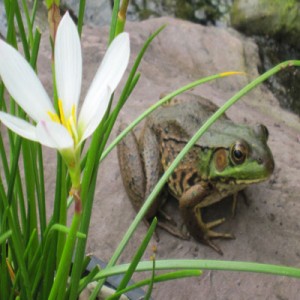 This frog is getting brave.....I can get close to him and it doesn't seem to matter. That is if I talk before I get to him so it doesn't frighten him. He likes to hid behind my Rain Lily. Maybe he just likes his picture taken hehe. I sure do alot of that. Now there are other frogs camping out in my pond also, but mostly small ones...the tadpoles from early spring. They aren't as friendly as MR. BIG FROG. Whenever I try and get close to snap a picture they jump right into the pond. This is the closest shot I could get....took one more step and he was gone.
This frog is getting brave.....I can get close to him and it doesn't seem to matter. That is if I talk before I get to him so it doesn't frighten him. He likes to hid behind my Rain Lily. Maybe he just likes his picture taken hehe. I sure do alot of that. Now there are other frogs camping out in my pond also, but mostly small ones...the tadpoles from early spring. They aren't as friendly as MR. BIG FROG. Whenever I try and get close to snap a picture they jump right into the pond. This is the closest shot I could get....took one more step and he was gone.
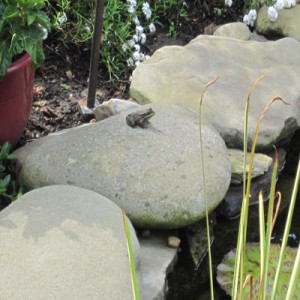 PLOP right into the pond. I think I saw Mr. Big Frog just shake his head....
PLOP right into the pond. I think I saw Mr. Big Frog just shake his head....
Since we're starting to get our ponds ready for the winter now is also a good time to create a place for those frogs we've watch grow from tadpoles this summer. You may want to put a tray, such as a kitty litter tray in the bottom of your pond with sand in it. This will give the frogs a place to bury themselves over the winter. Sometimes if you have a filter box or skimmer they may camp out there so be sure that your pump intake is protected so they don't get stuck in it. I've opened my skimmer early spring and had them jump out. If you have muck in the bottom of your pond they will also bury themselves in there. Its nature so frogs will find a way to survive over the winter.
Its such a great life for the frogs....sitting on the lily pads basking in the sun. Could life be any better???? These pictures were shared by one of our customers who received these tadpoles in the spring and now they are frogs enjoying the life in their new home. Thank you again for sharing your pictures.
Just another benefit that a pond can provide for our enjoyment and relaxation. Plants, boulders or fallen logs provide good sunny resting areas for frogs, dragonflies or turtles to take a breather.
Now that winter is approaching another good idea for those having frogs in their ponds is to provide a hiding place for the winter. If you need you can create an area for them by placing a container in your pond filled with sand. This will give the frogs a place to bury themselves for the winter. Make sure its deep enough so that if your pond freezes over it will be beneath the ice. Always leave an open space in your pond to provide oxygen for your friends.
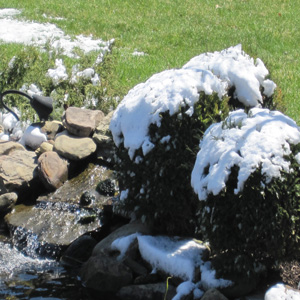 This is what some of us in the North woke up to this morning, and this was after some of it had melted. What happened to those 50 and 60 degree days??? Hopefully they will be back again soon. How can we get started cleaning our ponds and thinking putting those new plants in if the water is too cold to put our hand in it. And what about those fish and frogs???? They are hiding again.
This is what some of us in the North woke up to this morning, and this was after some of it had melted. What happened to those 50 and 60 degree days??? Hopefully they will be back again soon. How can we get started cleaning our ponds and thinking putting those new plants in if the water is too cold to put our hand in it. And what about those fish and frogs???? They are hiding again.
Whenever this happens, those of us who wanted our plants shipped thinking its finally warm wonder, now what do I do with them. Make sure you protect them by bringing them indoors until it warms up. Remember most of the plants have been indoors in a greenhouse environment and shiver even when the temps are in the 60s. But we need to make sure the water temperature have stabilized to 65 degrees before we put those floating plants out.
The floating water plants in your pond need to have the water temperature reach 65 degrees. They will show signs of yellowing leaves and black spots on their leaves if left in water temps below that. The water lettuce will wilt and turn white if too cold. We tend to get anxious in the spring and sometimes put floaters in before the water is warm enough. Even the lotus and waterlilies need the warmer weather to start growing. But at least those were outside all winter and were pulled to ship out.
Hopefully, like last year, this is a short spell and in a couple weeks things will turn around and we can once again start looking forward to enjoying our ponds.
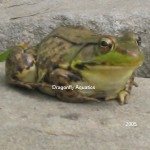 Tadpoles are social creatures and some will even interact and school like fish do. After about 6 weeks, you'll begin to notice tiny little legs start to sprout. The tadpoles we send normally have legs starting but some don't. You'll begin to notice the head gets more distinct and the body elongates. Their diet usually consists now of dead tiny insects unless you chose to feed them. Their arms begin to bulge and eventually pop out, elbow first. After about 9 weeks, the tadpole begins to look like a tiny frog with a long tail and is almost full grown. It takes approximately 6-12 weeks for a tadpole to develop into a frog. The temperature has a lot to do with it. During cold spells it may take a bit longer or even be suspended till the temperatures go up. So don't panic they will become frogs soon. Normally at about 12 weeks it looks like a tiny frog with a stub tail.
Tadpoles are social creatures and some will even interact and school like fish do. After about 6 weeks, you'll begin to notice tiny little legs start to sprout. The tadpoles we send normally have legs starting but some don't. You'll begin to notice the head gets more distinct and the body elongates. Their diet usually consists now of dead tiny insects unless you chose to feed them. Their arms begin to bulge and eventually pop out, elbow first. After about 9 weeks, the tadpole begins to look like a tiny frog with a long tail and is almost full grown. It takes approximately 6-12 weeks for a tadpole to develop into a frog. The temperature has a lot to do with it. During cold spells it may take a bit longer or even be suspended till the temperatures go up. So don't panic they will become frogs soon. Normally at about 12 weeks it looks like a tiny frog with a stub tail.
When a tadpole begins to develop his legs, they will need some sort of perch so they can get out of the water. Floating water lily leaves and branches are ideal for this, but you can also create ledges using stones. You don't have to feed tadpoles or frogs because they will fend for themselves. But if you choose to here are some suggestions. I found that if I feed them when they were tadpoles they became friendly and a couple of mine will eat out of my hand.
Tadpoles - Love Lettuce. You boil the lettuce for 10-15 minutes and drain it. Chop it up and they lay it on a tray to freeze it or put it in ice cube trays. Give them one cube every couple of days and that should be enough. When they first get their legs they aren't big enough to eat crickets so if you want to feed them start off with small insects or bloodworms (live is best). If you can't get them from you yard you can purchase them at a local pet store that carries fish. You can take a jar lid and put warm water in it and lay a bunch of wiggly worms in it and the frogs will find them. Or put them directly in the water. Aphids are also a good food source. Another item that you can feed your tadpoles are dog biscuits....no they won't bark....just crumble them up and the tadpoles will eat the crumbs.
FULL GROWN FROG
By about 14 weeks depending on what the frog eats and on the water supply and temperature, the frog will have completed the full growth cycle. He will begin to grow as you watch.
Usually frogs will be content to stay around your pond but if there is a water source nearby.....don't be surprised if they decide to venture to it. But usually will return. This happens alot of times when it rains. I have some frogs that never leave and some that do....not knowing if the ones that appear one day are the same ones that left.......
What I found surprising is that you can actually hold some of them. If you raise them from a tadpole and visit them regularly they will get accustomed to you and become your pet. Its harder to do if they are a frog when you get them. I start out by feeding them lettuce when they are tadpoles because when they are little insects and bloodworms are too big for them yet. Then I introduce the worms and insects.
They will soon become your friend and its fun watching them grow. Another interesting, nature watching process that gives you more enjoyment out of your pond.
Check out our frogs and tadpoles here.